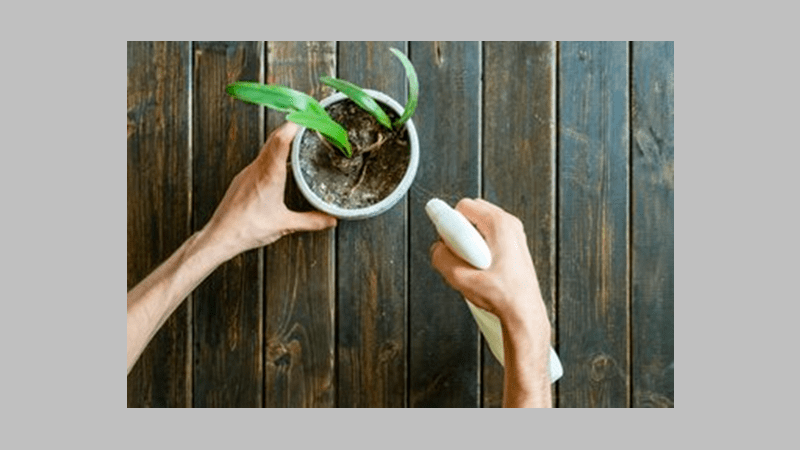If you have an array of houseplants adorning your house, you have probably noticed some bugs or flies around too. But, don’t worry. Most of the time, they do not cause any significant damage to your plants. One such insect that is commonly found hovering around indoor plants is the fungus gnat.
While they are not harmful to the plants or even you, it can be pretty annoying to see tiny flies swarming around your plants. So, here’s a brief overview of fungus gnats and how to get gnats out of indoor plants.
Fungus Gnats: An Introduction

Image source: Pinterest
Resembling fruit flies, fungus gnats are lean mosquito-like insects with long legs and transparent wings. The maggots or larvae are approximately 1/4 inch in size while adult fungus gnats can grow up to 1/8 inch long.
Fungus gnats do not have a long life span, with the entire life cycle from egg to adult gnat being about 3-4 weeks.
Fungus gnats are attracted to humidity and moisture. They permeate your plant’s soil, potting mix, and other forms of organic material.
The gnats’ larvae feed on the organic matter and fungi found in the plants’ soil, but they may also still chew on the roots of the plants and cause potential problems in nurseries, greenhouses, interior plantscapes, and simple potted plants.
Causes of Fungus Gnats in Plants

Image source: Pinterest
Fungus gnats are primarily attracted to moisture found in your pottingsoil. However, there are also other factors that can exacerbate a fungus gnat infestation.
1. Organic Debris
Fungus gnat larvae enjoy feeding on the organic material found in your potting soil. These pests breed by laying more than 200 eggs. Once these eggs hatch, the larvae feed on the available organic matter around them. So, if you have decaying plants or rotted plant roots, it’s a breeding ground for fungus gnats.
2. Wet Soil
Overwatering your plants can not only hinder their growth but also create the perfect environment for fungus gnats to breed. Wet and moist soil is the ideal environment for such flies. They will survive and go on a reproduction spree, resulting in a gnat infestation you wouldn’t want to deal with.
3. Light Source
Aside from moisture and organic debris, fungus gnats are also attracted to different light fixtures. They are drawn to the light from lanterns, lamps, and windows. And if you have plants nearby, you have just provided them with the perfect home.
Signs of Fungus Gnats

Image source: Pinterest
Fungus gnats are tiny insects, so it is not always easy to determine whether your plants are infested. However, there are some signs you can look out for.
#1. Your Plants Stop Growing
Adult gnats are not as harmful as the larvae because the larvae will feast on your plants’ roots. And if the roots are damaged, your plant can no longer absorb nutrients, which will hamper its growth.
#2. Yellow and Wilted Leaves
If the gnat infestation is significant, you will notice your plants having yellowing or wilted leaves. This is also a result of the larvae feeding on the roots.
#3. Flies Circling Above Your Plants
An obvious sign of fungus gnat infestation is a swarm of tiny flies around your plants.
#4. Visible Rotten Roots
Overwatering your plants can cause root rot, which will only attract more fungus gnats.
How to Get Fungus Gnats Out Of Plants: 5 Ways

Image source: Pinterest
#1. Get Rid Of The Old Soil And Repot
This is the most practical solution, especially if the potting soil is soaked with water and the plant roots have started to rot.
Make sure you let the roots dry out a bit on a paper towel and use fresh potting soil to repot your plant to ensure healthy growth. Even if there is existing damage on the plant’s roots, repotting it can salvage the plant and get rid of the gnats as the larvae will be left behind in the discarded soil.
#2. Bake Your Soil
This may be a bit fussy, but it works. It can even be a permanent solution to your gnat problem because it will kill all fungus gnats of varying life stages from your soil.
Set your oven to 200 degrees and place all the potting soil on a cookie sheet. Bake your soil for one hour and let it cool. You can now re-use this sterilized soil and re-plant your plants without the gnat eggs and larvae.
#3. Sprinkle Cinnamon On The Soil
Another cost-effective and readily available solution is sprinkling some cinnamon on the top layer of the soil. A natural fungicide, cinnamon can curb fungus gnats from breeding as well as prevent the soil from becoming too damp. This will help destroy the fungus that the larvae feed on.
#4. Use Hydrogen Peroxide
If you want an immediate solution, then using over-the-counter hydrogen peroxide can be very effective. It won’t harm your plants but it can instantly kill the eggs and larvae upon contact.
To use, mix one part of hydrogen peroxide with six parts of water. Make sure that the soil is completely dry before you use this mixture.
#5. Use An Apple Cider Vinegar Mix
Apple cider vinegar is attractive to gnats and works as the perfect bait for adult gnats. Fill a bowl or a wide-brimmed jar with apple cider vinegar and add a drop or two of dishwashing liquid.
Cover the bowl with a cling wrap and pierce a few holes using a fork. The gnats will start crawling through the cling wrap to get to the apple cider vinegar and end up drowning in the solution.
Tips for Prevention
Here are a few handy tips to prevent and eliminate fungus gnat infestation on your plants.
#1. Allow the top few inches of the soil to completely dry before you water your plant.
#2. Aerate the soil to encourage airflow.
#3. Adopt bottom watering for plants that need constant hydration.
#4. Maintain a watering schedule to keep your plants healthy.
#5. Use sticky fly traps for the adult gnats. No adults, no eggs.
#6. Sprinkle a layer of gravel or sand on top of your potting soil to prevent gnats from moving in.



